Cathedral of Srca Isusova - Cathedral of the Heart of Jesus
Cathedral of Srca Isusova - Cathedral of the Heart of Jesus
Cathedral Srca Isusova - Cathedral of the Heart of Jesus, Built between 1884 and 1889, it is one of the most visited places in central Sarajevo. The Roman Catholic Cathedral. The Cathedral of Srca Isusova, also known as the Sacred Heart and Sarajevo Cathedral, is a cathedral in Bosnia and Herzegovina. The largest cathedral It has the property of being. The cathedral, located in Başçarşı, the city's historic marketplace, has a magnificent architecture.
The Cathedral of the Sacred Heart of Jesus is an important religious and architectural landmark of Sarajevo, the capital of Bosnia and Herzegovina. The cathedral is the main Catholic cathedral of the country and is the center of the Catholic community of Bosnia. At the same time, the temple is the cathedral of the Archdiocese of Vrhbosna. The history of the cathedral began in 1881, and its construction was completed after a process that lasted several years. During the construction, original and remarkable elements were used in the architectural sense.
The architecture of the cathedral reflects a combination of neo-Romanesque and neo-Gothic styles. The project, designed by architect Josip Vancaš, was carefully created to reflect the religious and cultural fabric of the region. The construction process took about five years and the cathedral, which has a cross-shaped plan, was built. Overall, the cathedral is 41.9 meters long and 21 meters wide. 9 meters, the width is 21.3 meters. It's three meters. The facade is decorated with two square towers and a clock.
The interior of the cathedral is also remarkable. The sacred space is emphasized by the altar made of white marble. The statue of the Sacred Heart of Jesus on the altar is in line with the theme that bears the cathedral's name. The stained-glass windows that adorn the interior also contain colorful depictions of biblical scenes and heroes of the Catholic faith.
From a historical perspective, the Cathedral of the Sacred Heart of Jesus was damaged during the civil war in Bosnia and Herzegovina but was quickly restored. This is the restored cathedral, Pope II. It was visited by John Paul and continues to function as an important center of the Catholic Church.
The cathedral is located in the east of Sarajevo, next to the Marcale Market. There are various public transportation options for transportation.
At the same time, there is another Catholic church in Zagreb, Croatia, called the Basilica of the Heart of Jesus. This basilica was designed in Neo-Baroque style and built by Croatian architect Janko Holjac. This basilica, initiated by Archbishop Josip Stadler, was completed in 1902. The tomb of Blessed Ivan Merz is also located in the interior.
Both cathedrals have architecturally unique features and are important symbols of the Catholic faith and cultural heritage.
Cathedral Srca Isusova - Where is the Cathedral of the Heart of Jesus?
The Cathedral of Srca Isusova (Cathedral of the Heart of Jesus), It is located in the east of Sarajevo, near the Marcale market.
Places to visit in Sarajevo The Siege of Sarajevo and the Historical Expedition Plan, Plan of the Travnik trip to Sarajevo You can study the routes, if you want, from the relevant page. Plan your trip. You can create it.
Cathedral Srca Isusova - How to Get to the Cathedral of the Heart of Jesus?
The Cathedral of Srca Isusova - the Cathedral of the Heart of Jesus, You can take the city tram lines and get off at the stops on Başçarşı or Titova Street and walk to the cathedral. Among the nearest public transport stops are the Cathedral stop of bus number 31e and tram numbers 1, 2, 3, 5.
If you are travelling in your own vehicle, you can park your car and walk to the appropriate parking spaces on the Main Street.
Cathedral Srca Isusova - The history of the Cathedral of the Heart of Jesus
Cathedral Srca Isusova - Cathedral of the Heart of Jesus history, In 1881, when the diocese of Vrkhbosny received the status of an archdiocese, the cathedral known as the Cathedral Srca Isusova (Cathedral of the Heart of Jesus) appeared. Although this important development did not have the power to change the religious scene of the Balkans, the Catholic episcopate, based on the Latin rite. A new church. leads to a decision to set up. As a result, the project of the Cathedral of the Sacred Heart of Jesus was born and this new Catholic church was built on September 14, 1889.
The bell is an important element of Catholic churches and is also featured in this fifth cathedral. These bells are provided by donations from the Slovenian people and are donated to the Temple. The bells are provided by donations collected in Ljubljana. In this way, the Catholic community approved the archbishop's decision to build a new church. to express their joy the purposes.
Cathedral during the Civil War
The civil war in Bosnia ruthlessly destroys many historical and cultural works, but the Cathedral of the Sacred Heart of Jesus rarely experiences this misfortune. It's only slightly affected by the bombing, so the healing process won't take much time or money. After the cathedral was restored, Pope II, a turning point in the life of the Catholic Church and the Archbishop of Vrkhbosny. It is visited by John Paul and reopened.
Cathedral Srca Isusova - Architectural features of the Cathedral of the Heart of Jesus
Cathedral Srca Isusova - Heart of Jesus Cathedral architectural features can be arranged as follows:
- Designed by architect Josip Vantsas New techniques were used, combining neo-Gothic and neo-Roman elements. The cathedral, which took five years to build, has a wide nave and a three-nave plan. The cathedral is 21.3 meters wide and 41 meters long. It's three meters long and 41.9 meters wide. It's nine meters.
- The inner length 37.65 meters, the width is 18. It's 65 meters wide and 18.10 meters wide. It's 20 meters. It's 10 feet. The facade is surrounded by two towers, each tower is 43.20 meters high. It's 20 feet. The roofs are in the form of simple sharp pyramids, and the side naves extend to the south, while the middle naves extend to the front.
- At the roof level. In the upper part of the front, there is a five-arched recess. In this entrance, there are four blinds and an open arch in sandstone frames. Just below this section is a large blind arch and inside an eight-leafed rosette, these details are derived from two separate Gothic elements.
- The west tower. On the ground floor there is a baptistery, while in the eastern tower there is a staircase to the choir and bells. There is a chronogram inscription made of stone on the arch above this door.
- On the facade of the cathedral A window and a triangular frontispiece are seen, which is a distinctive feature of the Gothic style. These elements were handled with great interest by the architects. A less important feature of the style is the stained-glass windows, which are a great work of art.
- The main stained glass window, It depicts the crucifixion of Jesus by Longinus, one of the key moments of the Bible. The side stained glass windows depict scenes from the "Last Supper" and "Jesus, King of the Universe".
- Inside the building. There are also small stained glass windows dedicated to important figures of the Catholic faith. Heroes such as Margarita Maria Alakok and Julianna Liege are represented in these windows. But the most remarkable stained glass windows are those that completely cover the interior of the building. The colored rays entering through these windows create the reflection of the colored glass that brings to life the stories of the biblical heroes.
- The "heart" of the temple, The altar is made of white marble brought from Italy. As Jesus points to the Sacred Heart, the statue placed on the altar conveys a powerful message. The altar is surrounded by statues of saints and is decorated with white marble carvings.
The Cathedral of Srca Isusova - the Cathedral of the Heart of Jesus Places to Visit Around
- The headmaster (Baščaršija): The city's central marketplace, Başçarşı, is an area with many important buildings such as antique shops, cafes, restaurants, cafes and gift shops, as well as mosques, inns and madrasas belonging to Gazi Khusrev Bey.
- This is Sabil (Sebilj): Sebil, built in 1753 by Mehmet Pasha Kukavitsa, one of the Bosnian viziers of the Ottomans, is located in the upper part of Başçarşı. There are two more copies of this sebil in Belgrade and in America.
- The Clock Tower: The Clock Tower, built in the 17th century, was heavily damaged by fire and restored in 1762. The Clock Tower, built in the 17th century, was heavily damaged by fire and restored in 1762. This tower, which bears witness to the history of the city, is among the important structures that have survived, having been restored over time.
- Gazi Husrev Bey Mosque (also known as Gazi Husrev-Begova Džamija): The mosque, built in 1531 by Gazi Hüsrev Bey to the architect Sinan, was damaged during the Bosnian War, but was restored in accordance with the original in 1996.
- Gazi Khusrev Bey Madrasah is located in: The Gazi Hüsrev Bey Madrasah, the first educational institution in Bosnia and Herzegovina, has been providing education without interruption since its founding, including the war period. It was built in 1537 by Sultan Bayezit II's grandson and Semendire Sancak Bey Gazi Hüsrev Bey. It was built in 1537 by Bayezit's grandson and Semendire Sancak Bey Gazi Hüsrev Bey.
- Morić Hann or Morića Han: Morić Khan, popularly known as "Han-ı Atik", is located a little further from the madrassa. Built in 1551, the inn was restored after a fire in 1697. In addition to cafes, the inn is also home to shops selling authentic carpets and similar items.
- The Bezistan: The closed market place, built by Rustem Pasha in 1551 for the sale of Bursa Silk, nowadays also serves as the Sarajevo Museum.
- The Cathedral of Sarajevo (Katedrala Srca Isusova): The cathedral, built in 1889 and inspired by Notre Dame Cathedral in Paris, is also known as the Cathedral of the Sacred Heart of Jesus. This cathedral, which is considered the center of the Catholic community in the city, is located on Ferhadiye Street and is a 2-minute walk from the Gazi Husrev Bey Mosque.
- The Holy Mother Church of the Congregation (Saborna crkva u Sarajevo): In the garden of the Holy Mother Congregational Church, one of the largest Orthodox churches in Central Europe, is the Statue of the Multicultural Man. Part of the church, which is remarkable for its five minarets, is nowadays used as the Faculty of Economics.
- City Hall of Sarajevo (Gradska Vijećnica Sarajevo): Vijećnica, located on Obala Kulina Bana Street, at the extreme point of the capital, was built during the Austro-Hungarian period and was used first as a town hall, then as a national library. Known as the "Memory of Sarajevo", this building was heavily damaged by Serbian bombing during the Bosnian War, and more than 2 million historical documents and books were reduced to ashes. Restored in 2014, Vijećnica now serves visitors as a museum.
- Monument to the Eternal Fire (Vječna Vatra): This monument, located at the intersection of Marshal Tito Boulevard and Ferhadiye Street, was built in memory of those who lost their lives in World War II. It was built in memory of those who lost their lives in the World War. The fire at the monument has never been extinguished, except during the Bosnian War and some traffic accidents.
On the monument are the following statements in the colors of the Yugoslav flag:
With courage and blood shed together, the Yugoslav National Army consisting of Bosnian, Herzegovinian, Croatian, Montenegrin and Serbian brigades: Muslim, Serbian and Croatian patriots liberated the Republic of Bosnia and Herzegovina on April 6, 1945. To those who sacrificed their lives for this victory, with eternal gratitude and gratitude...
Cathedral Srca Isusova - Cathedral of the Heart of Jesus Visiting hours
The cathedral is closed on Mondays. From 9 to 17. It's from noon to 5:30. Thirty of them. It's open to visitors between hours.

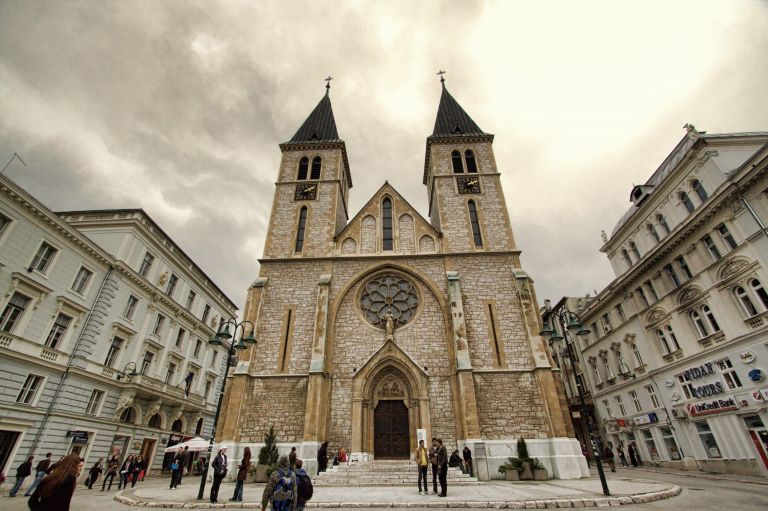


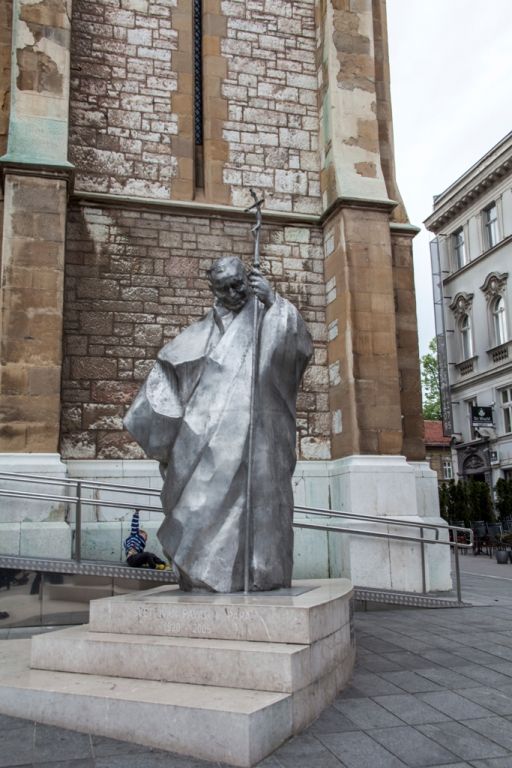
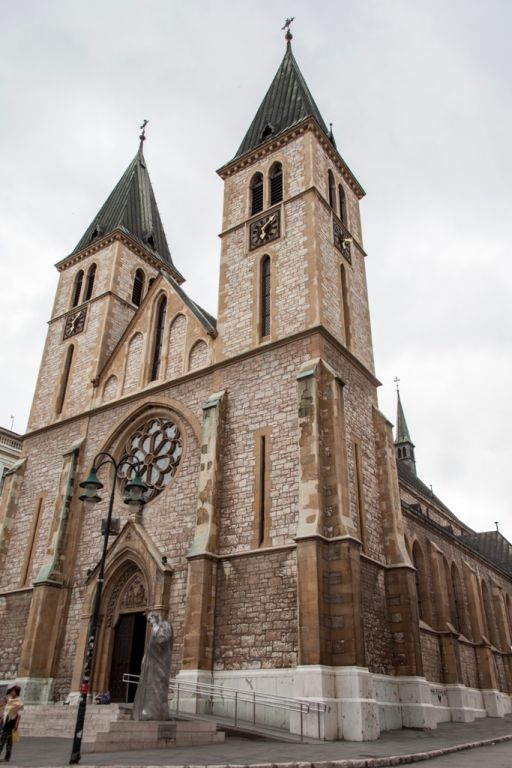








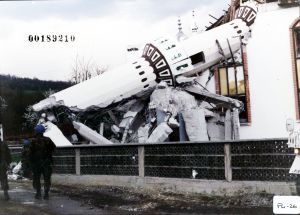

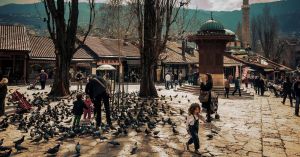
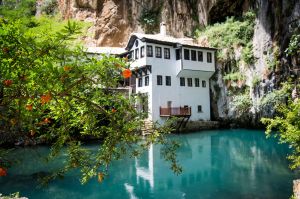
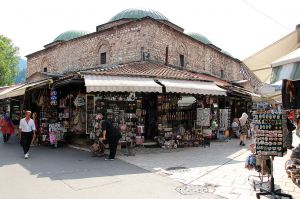
Değerlendirmeler